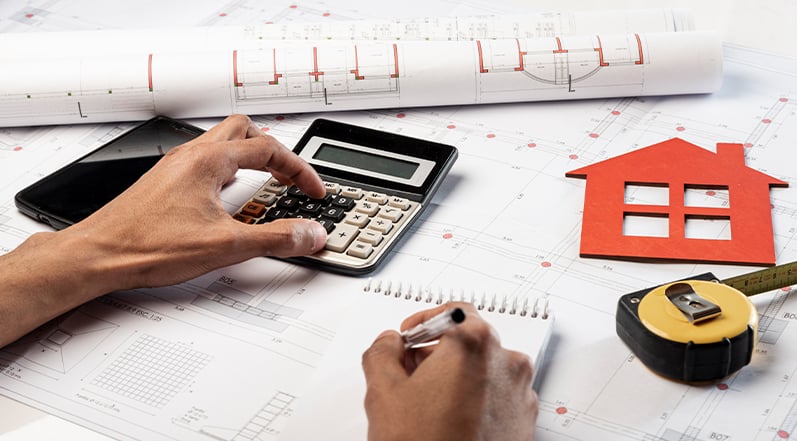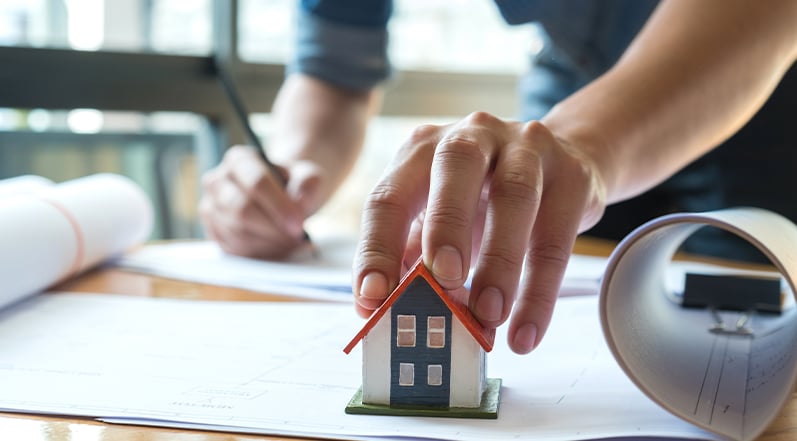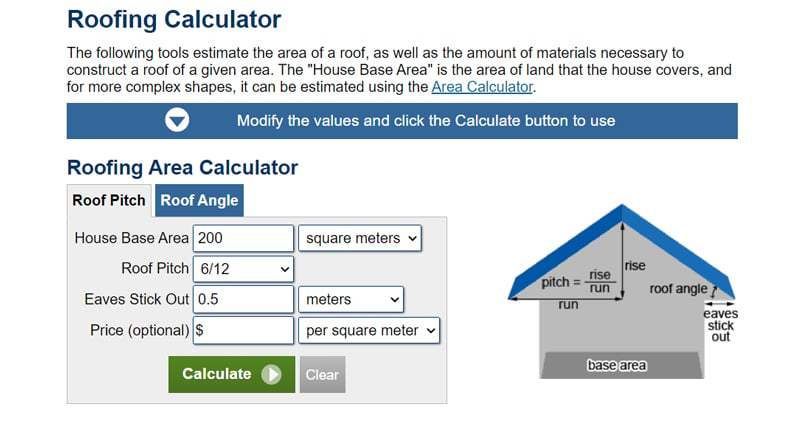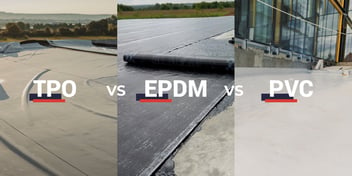- Home »
- Learningcenter »
- Measure square footage roof
5 Ways to Measure The Square Footage of Your Roof

When you’re considering replacing your roof, it can be hard to know how much money you should expect to invest in the project.
How much it costs to install a new roof is going to depend on the square footage of your roof, as this determines the amount of materials and labor required for the job.
Luckily for you, there are a number of ways you can estimate the square footage of your roof without breaking out the ladder. Let’s take a look at five ways you can measure your roof’s square footage, four of which allow you to keep your feet firmly planted on the ground.
Why Would You Need to Know the Square Footage of Your Roof?
“Square footage” is a term used to refer to the measurement of a two-dimensional space. One square foot is a square that measures 1 foot by 1 foot, while one hundred square feet is a square that measures 10 feet by 10 feet.

Measuring the square footage of your roof is important in roofing because it is used to calculate the labor and materials required to complete the job. It is also how the pricing of a job is determined, meaning that you can get a sense of how much a roof replacement will cost by calculating the square footage of your roof.
What Is a Roofing Square?
Before we look at the different ways you can measure the square footage of your roof, we should also touch upon the meaning of the term “roofing square.” Though you might assume that one “roofing square” equals one “square foot,” this isn’t the case. Understanding the difference between these two measurements is essential when you are communicating with a roofing contractor about the work that needs to be done.

In roofing, a “square” actually refers to a 100-square-foot area. This means that a 2,000-square-foot roof would require 20 squares of roofing material.
Are you replacing the roof on your home and planning on using asphalt shingles? Check out our recent post comparing three popular shingle brands: GAF, CertainTeed, and IKO.
5 Different Ways to Measure Your Roof’s Square Footage
So, how can you measure the square footage of your roof? There are a number of methods you can use, some of which are estimates that will give you a rough sense of the area you will need to cover during a replacement, while others are more precise.
1. Estimating the Square Footage From the Ground
Do you want to get a sense of the square footage of your roof without ever getting on a ladder? Though this method won’t result in a precise square footage measurement, it will get you within the ballpark of your roof’s square footage. Having this information can give you a general sense of how much a roofing job will cost once you understand the price per square foot or by roofing square.
The first step is to measure the length and width of the exterior of your home or building. Keep a notebook or a clipboard with you so you can write down the measurements.
If your home or building is a square or a rectangle, this will be very simple. For more complex shapes, you will want to measure each exterior wall to get a sense of the footprint of the roof.
Next, you will want to take a look at your roof and estimate the length of overhang if applicable. You can eyeball this measurement in feet and add them to the appropriate sides of the building to account for additional roofing material.
When you’re measuring, you’ll want to make sure that you include any bump-outs, such as garages or sunrooms.

Now you’ll want to calculate the area by multiplying the length and the width. For buildings with more complex shapes, you’ll want to break the diagram you made of the home’s footprint into rectangles and squares to find the square footage of each before adding them together. If parts of your building are shaped like a triangle or a trapezoid, the formula gets a bit more complicated.
To find the square footage of a triangle-shaped area, multiply the length of the base times the height and divide by two. For trapezoidal shapes, you’ll need to add together the length of the two parallel sides before multiplying it by the width and then dividing by two.
Finally, you’ll need to incorporate the slope of the roof into your calculation. If you don’t want to get up on your roof, you can do this from your attic:
- ● Grab a tape measure, a pencil, and a level
- ● Make a mark twelve inches from one end of the level
- ● Hold the level perfectly level against the bottom of a roof rafter
- ● Use your tape measure to measure from the twelve-inch mark vertically to the underside of the rafter
The number of inches discovered in step four is the number of inches that the roof rises in a foot. This is known as the roof slope. For example, if there are three inches between the level and the rafter, it means that your roof has a slope of 3:12.
Finally, you’ll now want to multiply the slope factor implied by the pitch of the roof by the square footage you found earlier. For example, the slope factor for a 3:12 roof is 1.0541.
Did you notice that your attic seemed stuffy and hot when you were measuring the slope of your roof? You might want to think about upgrading your ventilation system during your roof replacement or repair. Improving your ventilation system won’t just help your roof last longer and reduce the risk of mold and rot developing, but it can also help you save money on your energy bills and reduce wear and tear on your HVAC system.
2. Measuring the Roof Yourself (Carefully)
If you are feeling a bit more adventurous and are confident in your ability to get up on your roof, you can also measure the roof itself. You’ll want to make sure you take all necessary safety precautions if you’re going to go this route, as the last thing you need is to injure yourself trying to measure a roof. If you desire a more precise measurement than the method listed previously but are wary of getting up on your roof, it’s a much better idea to simply hire a roofing contractor to come over for a free consultation.
If you are going to measure the roof yourself, you’ll want to bring a tape measure and a notebook to write down the dimensions you find. Drawing a diagram of the roof is an essential step, particularly if there are complex shapes and angles that make up your roof. Divide each plane of the roof into its own section so that you can determine the square footage of each section.

Next, you will need to determine the pitch of your roof. If there are different pitches to the separate sections, you’ll want to calculate the slope of each one.
You can do this from inside your attic as described in the previous section, which is the easier method, or you can do so from on top of your roof. You will want to use a twelve-inch level to find the slope and hold it before measuring the distance between the roof and the end of the level. If there are three inches between the end of the level and your roof, for example, the slope is 3:12.
3. Using Satellite Imagery to Estimate Roof Square Footage
Modern technology really is amazing, isn’t it? You can estimate your roof’s square footage from the comfort of your home using your computer. This is thanks to satellite imagery and measurement tools available through Google Earth or Google Maps.
If you want to use Google Earth, you will want to open the program and find the location of your home. You can then click on the map to set your measurement points and determine the area of your roof in square feet on a two-dimensional plane.
For those of you using Google Maps, you’ll simply want to go to Google Maps using your browser and enter your address. You can then zoom in so you are looking right at your roof aerially and right-click on the first corner of your roof. Next, select measure distance and click on the second point of your roof to see the distance in feet.

Continue this process until you have measured the total footprint of your roof. You can now multiply the length times the width for simple rectangular structures, or you can divide the roof into simpler shapes, calculate the square footage of each area, and then add them together.
Now that you have the basic area of your home’s roof figured out, it’s time to incorporate the slope of the roof.
Using the method described earlier, you can now measure the slope of your roof in your attic. This is the easier way to do it rather than getting up on your roof. You’ll then want to multiply the square footage you found earlier with the slope factor to estimate the total square footage of your roof.
4. Using an Online Roofing Area Calculator
There are a number of free online roofing calculators available that you can use for your final calculation. You’ll need to measure the base area of your home and estimate how far the eaves stick out in order to have the necessary information to receive the total square footage of your roof. You’ll also need to know the pitch of your roof.

If you’re estimating the square footage of a flat roof, your life just got a little easier. While flat roofs aren’t entirely flat, their slope is much less dramatic than most residential homes. Flat roofs will typically have a minimal slope of ¼ inch per foot. If you are just looking for a very rough estimate of your square footage rather than a precise measurement, you can use the slope factor for ¼ per foot as a part of your calculations.
Once you have this information, though, an online roofing calculator can take care of the math for you. Beyond that, many of these tools will also help you calculate the materials that you will need for the size of your roof.
5. Have a Professional Roofer Offer a Free Consultation
As you can see, even getting an estimate of the square footage of your roof requires quite a bit of time and energy. No matter which method you choose, calculating your square footage is going to be a bit of a project. If you’re not interested in spending your free time up in your attic trying to figure out the slope of your roof, a much easier method is to call a professional roofing contractor and have them come out for a free consultation.
Chances are you’re interested in determining the square footage of your roof because it’s nearing time for a roof replacement. This is a big job that needs to be done well for your roof to be effective and long-lasting, and it’s generally advised that you hire a professional unless you’re certain that you will be able to do it safely and correctly.

When a roofing company comes out to give you an estimate for a roof repair, they will measure your roof in order to determine the amount of materials and labor that will be required for the job. Your roof’s size directly impacts the cost of the job on their end and on your end, so the easiest way you can learn about the size of your roof is by having pros come out and take a look.
Is It Time For You to Schedule a Free Roof Consultation?
Nothing in this life lasts forever, and roofs are no exception. If your roof is nearing the end of its life, estimating the square footage of your roof can help give you a sense of how much of an investment you will need to make in replacing your roof. That being said, the easiest way to learn the square footage of your roof and determine how much a replacement will cost is to have a reputable roofing company come out and offer a free estimate.

Is it time for you to replace your roof in the Atlanta area? If so, you’ve come to the right place. Colony Roofers specializes in offering high-quality roofs for the lowest prices, and we prioritize providing the absolute best customer service at the same time. We know that re-roofing your home is a big investment, and that’s why we do everything in our power to keep the process stress-free and easy for our customers.
If you’re ready to have pro roofers come out to take a look at your roof and help you understand what your options are, contact us today to schedule a free estimate.
 Call (678) 365-3138
Call (678) 365-3138



